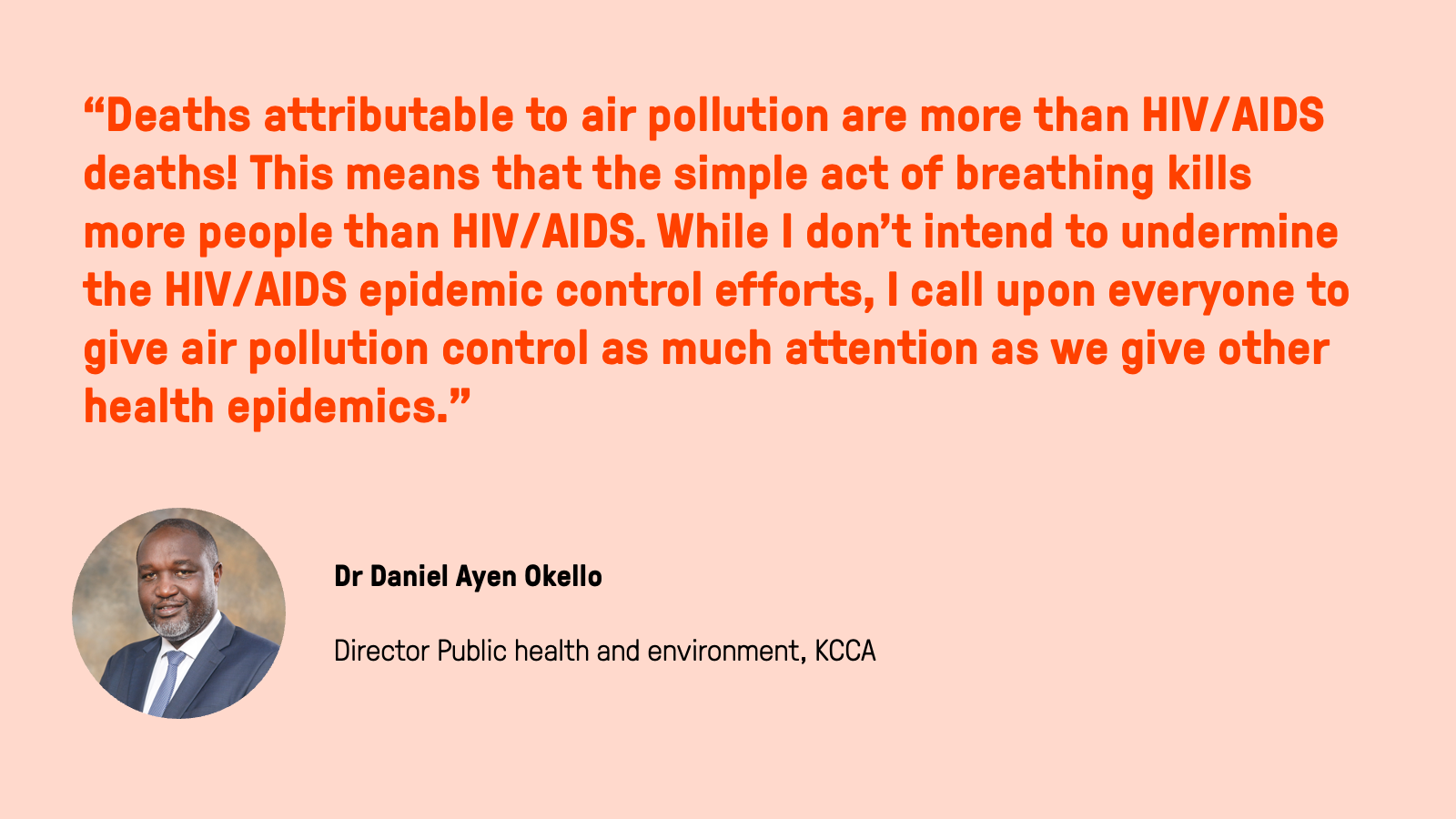
Health messaging to raise public support for clean air action
Kampala, Uganda
Case study developed in partnership with Kampala Capital City Authority
5 M
Kampala population size
7.8 times
the WHO air quality guideline of 5 μg/m3
(39 μg/m3 annual average PM2.5 concentrations)
$3,220
GDP per capita PPP
5.78 MtC02e
National GHG emissions per capita
Sources of emissions
Transportation
Waste Burning
Cooking With Solid Fuels
Industry
There is no clear leading emissions source in Kampala
Overview
Kampala is the economic and political capital of Uganda, with a growing resident and transient population of over 5 million. The city and its metropolitan areas contribute to over 60% of Uganda’s GDP, and host the largest concentration of pollution generating activities in Uganda. People in Kampala and the metropolitan areas live and work near pollution sources. Urban planning shortfalls have also precipitated the growth of dense informal settlement clusters, often intertwined with formal settlements and pollution generating activities. Based on 2021 data, it was estimated that 2,000 deaths a year, or 20% of total deaths, were attributable to long-term exposure to air pollution in Kampala.
The Kampala Climate Change Action strategy (2020-2025) recognizes the value of integrating clean air targets. However, to create even more explicit clean air targets, the Kampala Capital City Authority (KCCA) developed its Clean Air Action Plan in 2021/2022. The implementation of the three-year action plan began in 2023.
Left Photo: Joint team from the Kampala Capital City Authority and National Environment Management Authority on spot inspection of industrial facilities in the city. In this photo, the team was assessing compliance to air pollution control standards at a steel manufacturing plant (Roofings Uganda Limited).
Right Photo: The KCCA Executive Director, Dorothy Kisaka (Right) flanked by Director Public Health and Environment, Dr Daniel Okello launching the research equipment for the source apportionment study. Expected to be completed at the end of 2023, it will present findings about the sources of air pollution in the city, and help authorities to target air pollution mitigation measures to sectors contributing most to the pollution.
In 2018, prior to the development of the Clean Air Action Plan, the KCCA initiated air quality monitoring efforts, with actual measurements commencing in December 2019. Today, Kampala boasts a dense integrated network of low-cost and reference-grade monitoring stations that provide real-time data access that is used to guide decision-making and monitor the effectiveness of mitigation measures. With over 65 air quality monitors installed and more in the pipeline, it is possible to tell when and where pollution is high and to communicate safety messages tailored to pollution levels both for the general public and strategic stakeholders. KCCA’s air quality management plan also includes an emissions inventory to understand the leading sources of emissions, and, with support from the European Union, a source apportionment study to identify the precise sources of pollution is currently underway.
Photo Above: A screenshot of the Kampala Air Quality Monitoring Network (taken in November 2023) demonstrating how air quality can vary across the city. Each colored dot represents an air quality monitor.
The National Environment Management Authority has also recently developed standards for ambient air in Uganda, and the city authority is in the process of contextualizing these regulations to guide enforcement. Two key sources are expected to be the subject of regulations: household use of solid fuel and waste management. Even though the majority of the urban population is connected to electricity, most households still rely heavily on charcoal and firewood for cooking (Figure 1), and the use of open fires and traditional stoves have a strong influence on both indoor and ambient air quality levels. In addition, management of solid waste within Kampala is still a major challenge: In total, up to about 1,400 tons per day are generated within Kampala’s political boundaries alone. Yet, there is limited capacity for KCCA and municipal authorities within greater Kampala to safely manage all the waste generated. As a result, most of the waste is openly burned.
Figure 1: Proportion of Domestic Energy Profile for Greater Kampala (UBOS, 2015)
Photos Above: In March 2023, Kampala organised its first ever car free day. The event included community health screening, physical activities, and the promotion of active mobility. It demonstrated that roads aren’t for cars alone, a message to promote active transport in the city and to remind motorists to protect pedestrians.
Impact
One of the first priorities of the Kampala Clean Air Action Plan is improving people’s knowledge about the importance of clean air. The KCCA has developed messaging based on literature reviews and published evidence on the health effects and costs of air pollution, weaving in information about the multiple community benefits of reducing air pollution. To get these messages to the community, the KCCA has held press and media events alongside the National Environment Management Authority, Makerere University Lung Institute, and the Ministry of Health.
In March 2023 Kampala also held its first “car free day”, which involved closing some roads to vehicles, making them for walking or cycling only. This event, which is expected to be held regularly, demonstrates and promotes the use of car-free mobility. The event included a community health campaign, so participants were able to screen for various illnesses, donate blood, and participate in physical activities. The initiative attracted senior government officials including the state minister for Kampala, who spoke to the media about air pollution mitigation measures.
KCCA is also working with health experts to design and produce research outputs and technical reports on air quality. As part of the Partnership for Healthy Cities, KCCA is working with the Makerere Lung Institute, Vital Strategies and Eastern Africa GEOHealth Hub to conduct health-related studies on the air quality in Kampala, with a plan to translate these research outputs into specific policy initiatives.
In addition, Kampala has found it useful to leverage the health sector’s network and experience in risk communication. The house-to-house approach that was reinforced during the COVID-19 pandemic and more recently the Ebola virus disease outbreak has enabled the communication campaign to reach the community. Because many sources of Kampala’s pollutants are locally generated, having the support of the population will be extremely critical in accelerating policy formulation and behavior change for specific air quality control measures in the city.
Health highlights
The Kampala city government relies on the expertise and credibility of their health community, including academia and the Ministry of Health, to emphasize the importance of clean air to various stakeholders, such as decision-makers, health workers and the general public. The health messaging is based on literature reviews and published evidence on the health effects and costs of air pollution.
The city organized its first “car free day” in March 2023, which involved closing some roads to vehicles, making them for walking or cycling only. The event included a community health campaign, where participants were able to screen for various illnesses, donate blood, and participate in physical activities.
The city is currently working with the Makerere Lung Institute, Vital Strategies and Eastern African GEOHealth Hub to conduct health-related studies on the air quality in Kampala. In time, they plan to translate these research outputs into specific policy initiatives.
The city has also leveraged the health sector’s network and experience to disseminate information about air pollution risks and impacts. They adopted the house-to-house approach that was reinforced during the COVID-19 pandemic and the Ebola outbreak. Because many sources of Kampala’s pollutants are locally generated, having the support of the population will be extremely critical in accelerating policy formulation and behavior change for specific air quality control measures in the city.
Lessons learned
While one of the key concerns about implementing clean air action plans is maintaining the balance between livelihoods and air pollution mitigation, Kampala found that emphasizing the health benefits of clean air can be an effective way of getting communities to invest in interventions such as paying for their trash to be collected rather than burning it.
When the level of knowledge on the impacts of air pollution is low, focusing on its health effects resonates with stakeholders.
Lower income communities often suffer disproportionately from air pollution emitted by more privileged communities and economic actors. The KCCA is developing an innovative policy to empower citizen enforcement and reporting of air pollution emissions offenders.
It is important to operate a multi-stakeholder system to achieve air quality goals. This includes health authorities, environmental authorities, transport, energy, manufacturing and enforcement.
Strategic partners
The city would like to acknowledge the following partners in supporting its clean air and climate journey:















